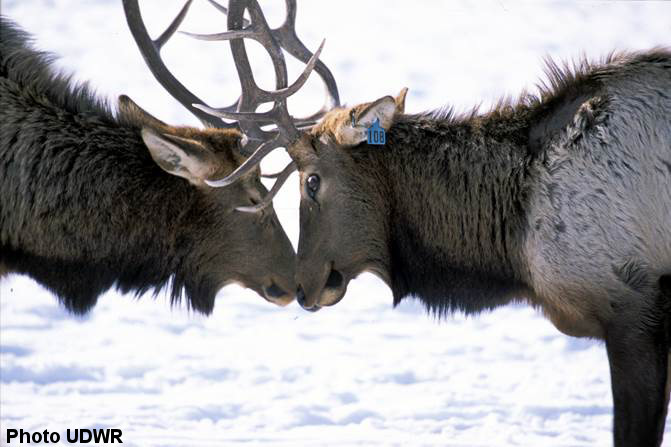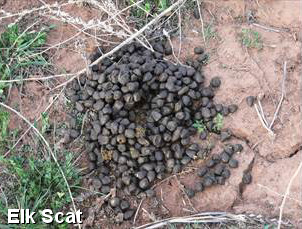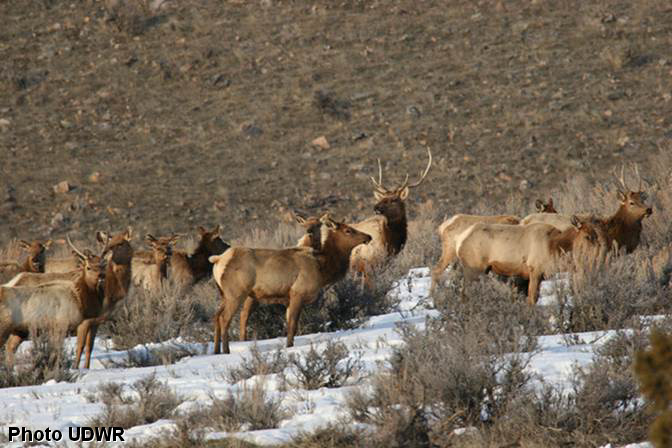Be Aware › Elk

Welcome to Elk Country
Some things you should know about elk
Rocky Mountain elk (Cervus elaphus nelsoni) are one of six recognized subspecies of elk found in North America, and the only type of elk in Utah. Elk are members of the cervidae family, which also includes moose, caribou and deer. In 1971, the Rocky Mountain elk was designated Utah’s state mammal.

Female elk (cows) typically give birth to one calf — twins are extremely rare — in late spring or early summer. When the elk calves are young, the cows gather together with them in large nursery bands of a hundred elk or more.
Only male elk (bulls) have antlers, which they shed and regrow every year. In early September through mid-October, during the elk breeding period — called the rut — you’ll hear the distinctive bugle of the bull elk as they gather cows into groups of 10–20 females and defend these “harems” from other bulls. During the rest of the year, bulls live in bachelor groups or alone.
Elk identification


Elk bugle
Both male and female Rocky Mountain elk have a light-brown body, dark brown head, neck and legs, and characteristic cream-colored rump. Bulls average 700 pounds and are about 5 feet tall at the shoulder; cows are slightly smaller at around 500 pounds and 4.5 feet.
- Mature bulls have large sets of antlers, usually with six points, called tines, on each side.
- Young bulls are sometimes called “spikes” because of their straight antlers.
- Elk tracks are about 4½ to 5 inches long; cow elk tracks are more slender and pointed than a large bull’s track.
- Elk droppings are bigger and longer than deer droppings.
- Bulls will often, but not always, leave their droppings in a pile. Cows often spread them while walking.
- Elk are most active at dusk and dawn.
Elk habitat & feed
Elk can be found throughout Utah in mountainous habitat. During the hot summer months, they live fairly high in the mountains — usually between 6,000 and 10,000 feet — and elk favor aspen forests for both forage and shelter.
In late fall, most elk migrate down the mountain slopes to areas of lower elevation and less snowfall — often called winter range — which is crucial for elk to find enough food to survive the winter and for cows to have healthy pregnancies.
During the winter, elk congregate in valley bottoms and forage on south-facing slopes where the sun melts snow more quickly and winds prevent deep snow from accumulating. These conditions provide access to more food sources, such as mountain shrubs and sagebrush.


Preventing elk conflicts
Elk generally avoid humans, but may be aggressive toward people and dogs, especially during the rut. If you encounter an elk, stay calm.
- Give elk a lot of space — elk can move much faster than you can!
- Be aware of elk behavior. Agitated elk hold their heads high, lay their ears back and flare their nostrils, and sometimes stomp their front hooves.
- Do not feed elk at your home or cabin. Feeding elk is strongly discouraged due to public safety concerns, the spread of chronic wasting disease among deer, elk and moose, and potential harm to wildlife from introducing foods not in their diets, particularly during winter months.
- Slow down while driving through elk habitats, especially at dawn and dusk, and during the spring and winter months when they are migrating.
If you find an elk calf
- If you find an elk calf, the best thing to do is keep your distance and leave the animal right where you found it.
- The calf’s mother will usually move away from the calf to feed and rest, but she will still remain close by.
- Because a calf doesn’t have a scent and it’s camouflaged so well, hiding the calf for its first few weeks of life is the best way the mother can protect it from predators.
- Do not approach! If you get too close, the scent you leave could draw a predator to the animal.
References
- Utah Division of Wildlife Resources Wildlife Notebook Series No. 12
- Utah Statewide Elk Management Plan

